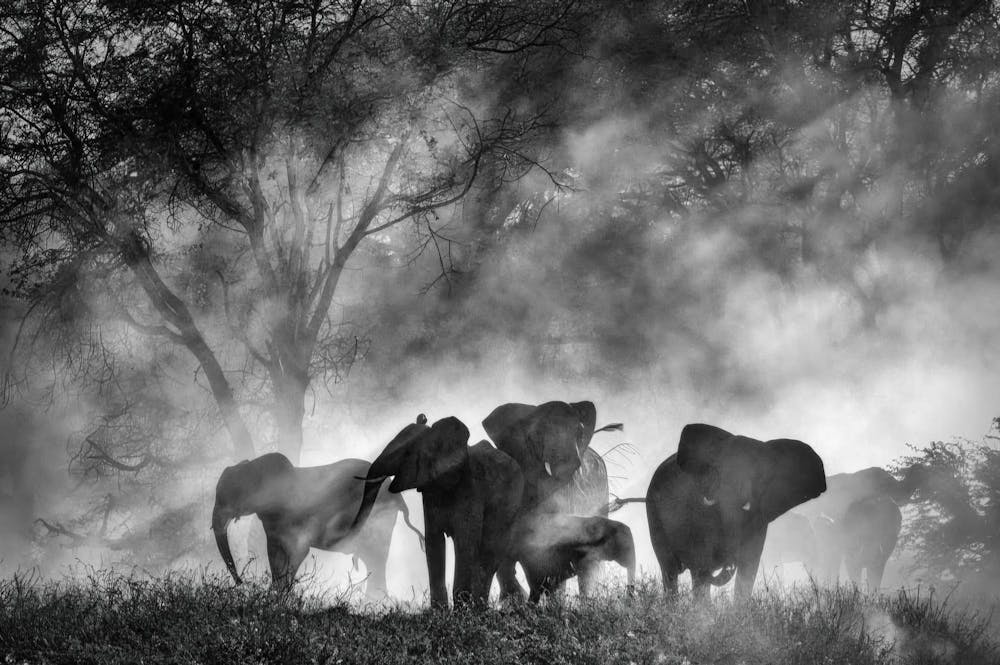The Virginia Film Festival screened “Ghost Elephants” Saturday, the latest directorial entry in German filmmaker Werner Herzog’s lauded filmography. The nature documentary follows National Geographic explorer Dr. Steve Boyes on an obsessive philosophical escapade through Namibia and Angola to investigate the mythical “ghost” descendants of “Henry,” the largest elephant ever recorded. Architecture Professor Emeritus David Phillips introduced the documentary, preparing audiences for the ruminative, poetic natural storytelling that Herzog’s art is known for.
“He doesn’t just document the stories of others in ways we might find typical … Herzog goes further,” Phillips said. “He takes part in their journey, editorializes, and sometimes goes on camera.”
Habitat loss, intensive poaching and a 27-year long civil war with arms partially financed by the illegal ivory trade have decimated Angola’s elephant populations. While most are thought to have fled the country post-war, according to local tribes, few supposedly remain in the water tower of Angola’s Highlands — a critical freshwater source for Southern Africa’s major rivers.
Compelled by these tales, Boyes’ recruits two Namibian “master trackers” considered to be the last of their kind and local translators on an expedition to the highlands. They complete a one week journey from Namibia to the remote alleged elephant site, wading through harsh terrain with extensive camera and DNA testing equipment. Henry, who is now the centerpiece of the Smithsonian Museum of Natural History in Washington D.C, was killed in 1955 with seemingly no descendants. His readily available DNA samples, however, provide the opportunity for the crew to identify others of his rare kind.
Shannon Worrell, class of 1990 alumna and audience member, said that the documentary’s topic was personally moving as she had been exposed to poaching in her childhood.
“I come, unfortunately, from a family that has big game hunting in their history,” Worrell said. “I was always sort of disgusted by that history in our family, so I was very moved by the work that the filmmaker and the scientists were doing.”
Herzog’s contemplative and measured approach to documenting the expedition affords Boyes and other recruited explorers an almost uncomfortably long amount of time to meditate on the mission’s meaning in the film. The pursuit of these animals is often portrayed as a direct metaphor for the exploration of what is hidden and unknown, thought-provokingly testing the limits of human curiosity and knowledge.
Boyes himself wrote on his Instagram page about the mental toll the search took on him.
“They had broken me. I wished no one, even me, knew about them. I wanted to believe they could always be there; ghosts walking silently in the moonlight far away from anywhere,” Boyes said. “I'll never forget those first months searching for the ghost elephants. Even now, I can feel them.”
However, considering that Boyes has been deeply involved in environmental efforts in the Angolan highlands for a decade, the documentary misses opportunities to go deeper into how Boyes’ life has changed as a result. Herzog introduces the protagonist while he is already worn and grizzled, which in some ways fails to depict his emotional odyssey from its very start.
Still, given the constant introspection throughout the documentary, audience members are allowed the space to form their own interpretations on the rough subject matter.
“Part of me also kind of just wishes they would leave [the elephants] alone,” Worrell said. “I think that's just the conundrum of the film itself, because the lead scientist partly talks about how he doesn't even want to find the elephants because he wants them to remain in that realm of mystery and safety.”
For the master trackers helping Boyes navigate the Kalahari wilderness, elephants were immensely spiritually meaningful — they are considered to be ancestors and are the focus of rituals that the film captures intimately. Herzog’s close-up storytelling overall is undeniably immersive and effective, particularly in capturing the distinct cultures the crew encounters during the expedition.
A handful of locally recited beliefs — such as the elephants having the power to transport their spirits into humans or listen to human conversations — make the quest all the more epic and transcendental. Herzog masterfully pulls audiences out of their comfort zones and into the documentary’s unforgiving physical landscape and evocative philosophical one.
In addition to that thematic strength, “Ghost Elephants” has a remarkably diverse, awe-inspiring visual language. Herzog meshes extended wide shot stills of remote natural landscapes, raw wilderness and vast skies with his patient long-form interview style and steady storytelling. Concurrently, his handheld camerawork, especially across the crew’s arduous week-long trek from Namibia into Angola, is intimate and gripping.
The variation in setting at some points, however, is so drastic that it becomes off-putting. After being deeply immersed with hunter-gatherer societies and shrouded in the orange hues of a desert, sequences in sterile state of the art laboratories feel like they come from an entirely different work.
To assist in setting and story transitions, Herzog bluntly narrates “Ghost Elephants” with monotone remarks that are insightful and dryly comedic, offering a respite from the sometimes heavy material being covered. Graduate College student Taylor Myers-Brower said that the narration was a highlight of the film.
“I've never seen a Werner Herzog movie before, and I really appreciated the moments where he interjected himself into the film. I thought it brought a lot of humor,” Myers-Brower said.
His narration often overlays a score composed of tribal music native to the documentary’s setting, adding to the geographical and cultural immersion within the remote areas. The score is atmospheric, striking and grand, at a scale equally as large as the task Boyes and his team face.
Over its 98-minute runtime, “Ghost Elephants” is a sophisticated, moving exploration of the beauty and mystery of elephant wilderness, indigenous societies and man’s intrinsic thirst for adventure. The documentary will be available for streaming on Disney+ and Hulu in 2026.







